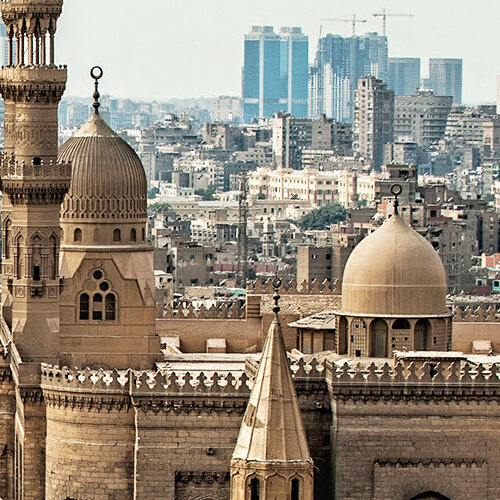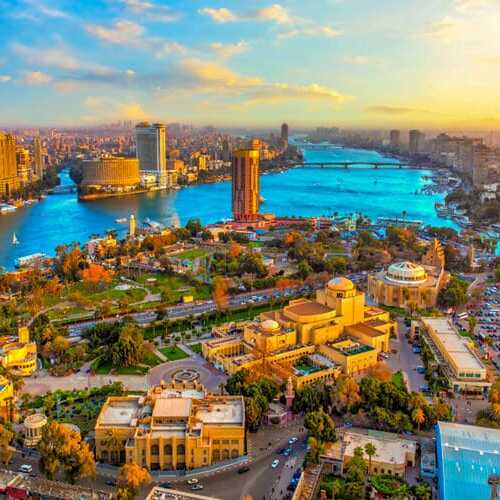No other nation in the world says ‘Welcome’ as often as the Egyptians, and every time, they mean it. While the ancient civilization of Egypt continues to amaze, contemporary Egyptians are equally remarkable.
Madrassa & Mausoleum of as-Salih Negm El-Din Ayyub
Mausoleum of As-Salih Negm El Din Ayyub: Where History and Legacy Converge
In the heart of Cairo’s rich historical tapestry, a 12th-century complex stands as a silent witness to the ebb and flow of time. The Mausoleum of As-Salih Negm El Din Ayyub, once a high court during the illustrious Mamluk era, carries within its walls the echoes of generations past.
This venerable institution served as the crucible for countless influential Cairo judges, its theological school a beacon of enlightenment and scholarship. Its roots trace back to the Ayyubid era, a dynasty established by none other than the legendary Saladin, known as Salah ad-Din, whose name resonates through the corridors of history.
Adjacent to this hallowed ground lies a tomb, a sepulcher that cradles the mortal remains of Sultan Ayyub himself. This sacred space, constructed in 1250, holds a tale of love, intrigue, and determination. It was the vision of Shagarat al-Durr, his Turkic wife, to immortalize his memory, a vision she pursued with unwavering devotion after his passing.
Yet, the tomb remained a well-guarded secret, veiled in silence, for Shagarat al-Durr harbored a singular purpose. She sought to prevent the French crusader armies, then stationed in Damietta, from exploiting the Sultan’s demise. Her resolve was unwavering, and her determination unyielding.
In time, her valor triumphed, as she led a victorious campaign against the Crusaders, earning her the title of Sultana and a place in the annals of history. Her rule endured until the era of the Mamluks, when the Turkic janissaries assumed power, marking a transition in the destiny of Egypt.
The Mausoleum of As-Salih Negm El Din Ayyub stands as a living testament to the convergence of history and legacy. It is a place where the aspirations of rulers and the resilience of the people have left an indelible mark. Here, the past whispers its secrets to those who listen, inviting travelers to immerse themselves in the rich heritage of Egypt and the enduring spirit of its people.
Created On May 4, 2020
Updated On July 21 , 2025
CAIRO Travel Guide
- Al-Azhar Mosque
- Al-Azhar To The Citadel
- Amir Taz Palace
- Aqsunur’s Mosque
- Bab Zuweila
- Beit Al-Harrawi
- Beit Al-Suhaymi (Al-Suhaymi House)
- Beit Zeinab al-Khatoun
- Bein al-Qasreen STREET (Between The Two Palaces {Street})
- Ben Ezra Synagogue
- Church of St. Barbara
- Coptic Cairo
- Egyptian Textile Museum
- Gawhara Terrace
- Gayer-Anderson Museum
- Ibn Tulun Citadel
- Khan Al-Khalili Bazaar (Cairo’s Most Famous Bazaar)
- Khanqah & Mausoleum of Sultan Baybars al-Gashankir
- Khanqah-Mausoleum of Farag Ibn Barquq
- Madrassa & Mausoleum of as-Salih Ayyub
- Madrassa & Mausoleum of Qalawun
- An-Nasir Mohammed Bin Qalawoon Mosque
- Madrassa And Mausoleum of Barquq
- Mausoleum of Al-Ghouri
- Midan Al-Hussein (Sayedna Al-Hussein Square)
- Mosque of Al-Hakim
- Mosque of Al-Mu’ayyad Shaykh
- Mosque of al-Aqmar
- Mosque of Amr ibn al-As
- Mosque of An-Nasir Mohammed
- Mosque of Aslam al-Silahdar
- Mosque of Ibn Tulun
- Mosque of Mohammed Ali
- Mosque of Sayyidna al-Hussein
- Mosque-Madrassa of Al-Ghouri
- Mosque-Madrassa of Sultan Hassan
- Mosque-Madrassa of Umm Sultan Sha’aban
- Museo Mevlevi
- Museum of Islamic Art
- Northern Cemetery
- Northern Enclosure
- Northern Walls and Gates
- Sabil And Kuttab Of Abdel Rahman Katkhuda
- Sabil of Muhammed Ali Pasha
- Sharia al-Muizz li-Din Allah
- The Church of St Sergius & Bacchus
- The Citadel Of Saladin
- The Complex of Sultan Ashraf Barsbey
- The Coptic Museum (The Only Coptic Museum In Egypt)
- The Egyptian Museum
- The Hanging Church
- The Khayrbek Complex
- The Mosque of Sultan Qaitbey
- The Roman Towers
- Wikala al-Bazara
- Wikala of Al-Ghouri



